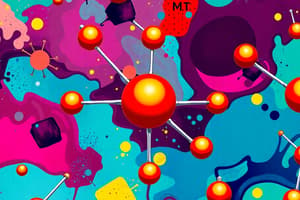Podcast
Questions and Answers
What is the physiologically important role of selective enhancement of affinity in globins?
What is the physiologically important role of selective enhancement of affinity in globins?
It helps prevent poisoning by CO generated from metabolism and our industrial-age environment.
How does the binding of oxygen to the heme in myoglobin depend on the protein structure?
How does the binding of oxygen to the heme in myoglobin depend on the protein structure?
It depends on molecular motions or 'breathing' in the protein structure.
Why is it important for the protein structure to have transient cavities?
Why is it important for the protein structure to have transient cavities?
Transient cavities allow oxygen to move in and out of the heme pocket.
What role does the distal His residue play in myoglobin?
What role does the distal His residue play in myoglobin?
How does the pocket near the heme iron in myoglobin open and close?
How does the pocket near the heme iron in myoglobin open and close?
What is the main function of hemoglobin in animals?
What is the main function of hemoglobin in animals?
What is the size and shape of normal human erythrocytes?
What is the size and shape of normal human erythrocytes?
What are precursor stem cells for erythrocytes called?
What are precursor stem cells for erythrocytes called?
What happens to the organelles of daughter cells during the maturation process of erythrocytes?
What happens to the organelles of daughter cells during the maturation process of erythrocytes?
How is most of the oxygen carried by whole blood in animals transported?
How is most of the oxygen carried by whole blood in animals transported?
Which of the following is true about the selective enhancement of affinity in globins?
Which of the following is true about the selective enhancement of affinity in globins?
What is the role of the distal His residue in myoglobin?
What is the role of the distal His residue in myoglobin?
What is the main function of hemoglobin in animals?
What is the main function of hemoglobin in animals?
Why is it important for the protein structure to have transient cavities?
Why is it important for the protein structure to have transient cavities?
How does the pocket near the heme iron in myoglobin open and close?
How does the pocket near the heme iron in myoglobin open and close?
What happens to the organelles of daughter cells during the maturation process of erythrocytes?
What happens to the organelles of daughter cells during the maturation process of erythrocytes?
What is the size and shape of normal human erythrocytes?
What is the size and shape of normal human erythrocytes?
How is most of the oxygen carried by whole blood in animals transported?
How is most of the oxygen carried by whole blood in animals transported?
What is the physiological importance of the selective enhancement of affinity in globins?
What is the physiological importance of the selective enhancement of affinity in globins?
How does the binding of oxygen to the heme in myoglobin depend on the protein structure?
How does the binding of oxygen to the heme in myoglobin depend on the protein structure?
Flashcards are hidden until you start studying




